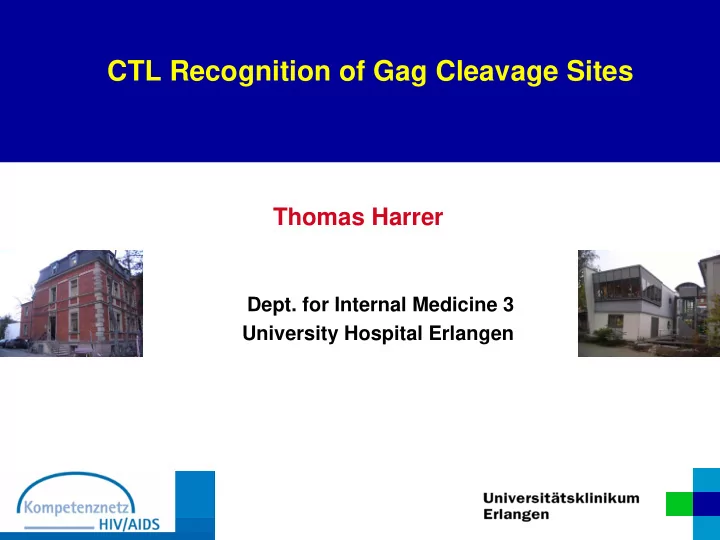

CTL Recognition of Gag Cleavage Sites Thomas Harrer Dept. for Internal Medicine 3 University Hospital Erlangen
Protease cleavage site mutations Role of the immune system ? Cote, JV 2001
HLA A 2 HLA CW HLA A3 8 CTL TCR HIV HLA B27 HLA CW 4 HLA B7
Tat vif Rev vpu Gag LTR LTR vpr Pol Env Nef HLA A2,A3 HLA A24,A32 B27,B8 B14,B51 Cw3,4 Cw5,8
Prevalence of mutations in the NC/P1-Cleavage Site in 93 patients T E R Q A N F L G K I 13 6 2 - 2 2 - - 1 19 8 Significant correlation to HLA alleles in red
TERQANFLGKI – NC/p1 Cleavage Site Statistical Correlations of mutations to HLA-I in 93 patients Aa HLA Allele p-wert odds Ratio n= T A32 0.054 13.82 3 T A28 0.05 4.44 11 E B40 0.049 10.13 6 R B61 0.043 89 2 K B64 0.041 21 2 K B41 0.041 21 2 I B13 0.036 5.46 17 T B40 0.037 3.7 6 K B35 0.024 4.35 13 Ins TNE A1 0.016 3.4 24 T B45 0.019 33.7 2 E A32 0.011 42 3 E B61 0.004 95 2 K Cw8 0.042 20.71 2 K Cw2 0.034 0.1 15 T Cw16 0.014 8 8
Analysis of CS mutations in Resina by Jens Verheyen (Drug Resistance Workshop, Sitges 2008) • C-terminal CS-mutations frequent in HIV without PI resistance (n=40) 436R (18%) in NC/P1 437L (8%) 449P (38%) 451N (10%) 453T (10%) 453L (13%) • 436R significantly correlated with HLA-B13 (p<0,05) (but could also be found in HLA B13 negative patients).
Influence of NC/P1- mutations on recognition by HLA B13-restricted CTL RQAN / FLGKI --V- ----- ---- ---R- The A to V mutation was observed in 29% of PI-treated patients but in none of the controls (only NRTI - therapy) Cote, JV 2001. The K to R – mutation correlated to HLA B13
Influence o e of t the A e A/V - C - Compensatory C y Cleavage S e Site M Mutations on CTL Recognition on CTL Recognition in 3 HLA B13 + Patients. n 3 HLA B13 + Patients. 3 SFU/100 000 PBMC --V------ 2 --A------ no peptide 1 0 20 40 60 80 100 120 140 160 RQANFLGKI epitope
Different patterns of recognition of CS-mutations 150 250 SFU in RQANFLGKI-stimulated PBMC RQANFLGKI RQVNFLGKI RQANFLGRI 125 200 RQANFLGKI SFU / 100 000 PBMC 100 Patient #SSY RQVNFLGKI 150 75 RQANFLGRI 100 50 50 25 0 0 10 µg/ml 1 µg/ml 100 ng/ml 10 ng/ml 10 µg/ml 1 µg/ml 100 ng/ml 10 ng/ml peptide concentration peptide concentration 20 60 RQANFLGKI RQVNFLGKI RQANFLGRI 18 RQANFLGKI RQVNFLGKI RQANFLGRI 50 16 SFU/2*10 5 PBMC SFU/1*10 5 PBMC 14 Patient #2 40 12 Patient #3 10 30 8 6 20 4 10 2 0 0 10 µg/ml 1 µg/ml 100 ng/ml 10 ng/ml 10 µg/ml 1 µg/ml 100 ng/ml 10 ng/ml peptide concentration peptide concentration The TCR quality decisive for recognition of mutations
Summary • Cleavage site mutations are correlated with several HLA alleles suggesting an influence of CTL on emergence of cleavage site mutations. • A431V and K436R in NC/P1 – CS can influence recognition by HLA B13 – restricted CTL, dependend on the quality of the individual T-cell receptor. • K436R seems to be selected in HLA B13+ patients, but can emerge also in HLA B13 – negative patients • More patients needed to assess an influence of CTL on A431V (so far only 1 of 4 patients HLA B13+).
• Sandra Müller Bernd Spriewald • Kathrin Eismann Hauke Walter • Silke Bergmann Klaus Korn • Pia Rauch Jens Verheyen • Ellen Harrer Rolf Kaiser Kompetenznetzwerk HIV/AIDS DFG, Hector Stiftung, IZKF Erlangen
n HLA n mutations both + A32 x T 3 13 2 A28 x T 11 13 4 B40 x E 6 6 2 B61 x R 2 2 1 B61 split of B40 B64 x K 2 19 2 B41 x K 2 19 2 B13 X I 17 8 4 B40 x T 6 13 3 B35 x K 13 19 6 A1 x Insertion 24 5 4 B45 x T 2 13 2 A32 x E 3 6 2 B61 x E 2 6 2 B61 split of B40 Cw8 x K 2 19 2 Cw2 x K 15 19 0 negative correlation Cw16 x T 8 13 4
Published CTL Epitopes in NC/P1 Cleavage Site KEGHQMKDCTERQANFLGKIWPSYKGRPGNF KEGHQMKDCTERQANF A2 HQMKDCNERQAN A2 CTERQANFL B61 TERQANFL B*4002 RQANFLGKI B*13 FLGKIWPS A2 FLGKIWPSYK A*0201 KIWPSYKGR A*3101
1000 1200 RQANFLGKI RQVNFLGKI RQANFLGRI RQANFLGKI RQVNFLGKI RQANFLGRI SFU in RQVNFLGKI-stimulated cells 900 SFU i: RI9-K/R stimulated cells 1000 800 700 800 Patient #R Patient #R 600 500 600 400 400 300 200 200 100 0 0 5 µg/ml 1 µg/ml 100 ng/ml 10 ng/ml 5 µg/ml 1 µg/ml 100 ng/ml 10 ng/ml peptide concentration peptide concentration 900 RQANFLGKI RQVNFLGKI RQANFLGRI 800 SFU in 10E5 peptide PBMC 700 600 Patient #R 500 400 300 200 100 0 10 µg/ml 1 µg/ml 100 ng/ml 10 ng/ml peptide concentration
Resina - Cohort 70 HIV genotypes from therapy-naïve patients Primary resistance in RT and Pol in 30 patients. All genotyped for HLA-A and HLA-B Analysis of CS mutations by Jens Verheyen (Köln)
Recommend
More recommend